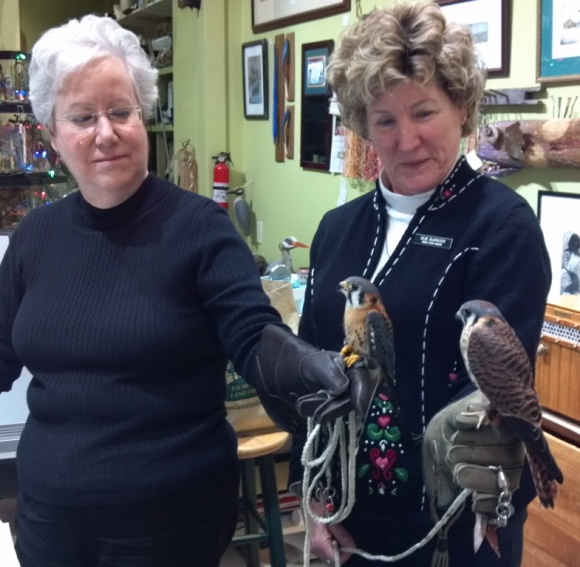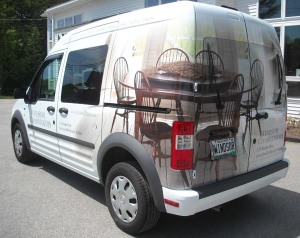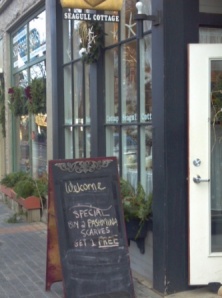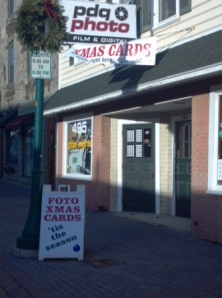
Marketing handouts and promotional gimmes exhibit the Pilot’s visual branding, which relies on fashionable colors and bold design.
How does a news medium market itself? That’s the question The Penobscot Bay Pilot faced before it launched in September, becoming the Midcoast’s newest news source and advertising venue.
Almost any other type of company would send news releases to the local media, and run a few ads saying “We’re here!” In addition, those ads might promote a “Grand Opening Special!!!” (can’t forget the exclamation points!) to get people through the door and overcome the natural resistance among potential customers or clients to changing suppliers.
But that approach obviously wouldn’t work for the Pilot: sending news releases to the VillageSoup newspapers would be an explicit acknowledgment of their importance as a news medium in the region, and it’s questionable whether the Soup would run the news in any case. And it would be a bitter pill indeed to purchase ads from a direct competitor for local advertising dollars.
Instead, the Pilot based its launch strategy on a combination of distinctive branding, social media marketing, and personal contacts. Sales Directors Terri Mahoney and Janis Bunting say that they didn’t solicit advertising until the day the site went live. As soon as they had something to show potential advertisers, however, Mahoney and Bunting began an aggressive push, targeting 20 organizations with whom they had done business in their previous roles selling ads for Village NetMedia, the former owner of the VillageSoup brand. “Just getting out and meeting people face to face and showing them what we have available” has been one of the new company’s most productive marketing strategies, says Mahoney.
By offering free trials of the Pilot‘s Affiliate program to those former clients, they overcame initial resistance and had all 20 come on board. This leant the site credibility and in turn encouraged other advertisers. (Many of the original 20 organizations have been successfully transitioned into paid Affiliate status.)
Online marketing has taken off in several complementary, directions. Of course the Pilot maintains a Facebook page (current “likes,” about 3,600), and has a Facebook “Main Street” page for its advertisers “designed to make it fun, easy and rewarding to put your money where you live,” according to Mahoney. They’re also active on Twitter, and their Pinterest account has followers who appreciate the separation of content into various pin boards for news, sports, recipes, etc. The most popular board is Contests, Giveaways and Free.
Perhaps the most strategic element of the Pilot‘s social media program is to make the site itself a social medium. Readers are invited to submit stories and upload their own photos. With the website’s tight integration of all common social media platforms, readers can then easily forward their own photos to friends and acquaintances and share them on their own Facebook walls. This goes beyond simple reader engagement and helps create emotional investment in the medium. Reader uploading took off in a big way during the recent winter storm that was named for a cartoon fish (Sorry, Weather Channel, but we’re not on board with you branding public weather events.), and it got another boost a day or two later during the National Toboggan Championships.
Photo uploads are further encouraged by the QR code on a giveaway tote bag, and by another, more unusual gimme: an “egrip.” These are little imprintable rubber pads that you stick on the back of your mobile phone to prevent it from sliding around on your car’s dashboard. The Pilot‘s version is imprinted with the message “See Something? Shoot it/Share it” with an upload address.
Branding, too, played an important role in the launch. Working closely with Adventure Advertising, the Pilot developed a striking visual identity that relies on large blocks of contrasting, contemporary fashion colors, lots of “white space” (which isn’t white), and unusual but not inconvenient organization of content. Business cards and rack cards were printed in non-standard sizes which, while distinctive, may involve some functionality tradeoffs (for example, the square business cards don’t fit in a wallet). But aggressive face-to-face efforts by Mahoney and Bunting have been successful in getting the 7″X7″ rack cards placed in many stores, restaurants, cafés and even libraries, even though they don’t fit in a typical literature-rack pocket.
Whether seen individually (each staff member has a different color business card) or together (as on a car wrap), the designs and colors are eye-catching and memorable. “Adventure Advertising was extremely helpful,” says Mahoney. “They were instrumental in a lot of our creative concepts and were a great organization to work with.” And the sales directors have some attractive, high-value goodies at their disposal, including color-coordinated travel mugs, tote bags, and a logo-inscribed yellow rubber “cause bracelet” that conceals a USB drive. (Disclaimer: this blogger received all of these goodies, and they are awesomely cool.)
The Pilot still faces better-established competitors, most notably, the VillageSoup newspapers and website, and their cousin publication The Free Press. But the Pilot‘s innovative marketing efforts and its proposition of free news for all readers look to be a combination for success for this new local medium.


























